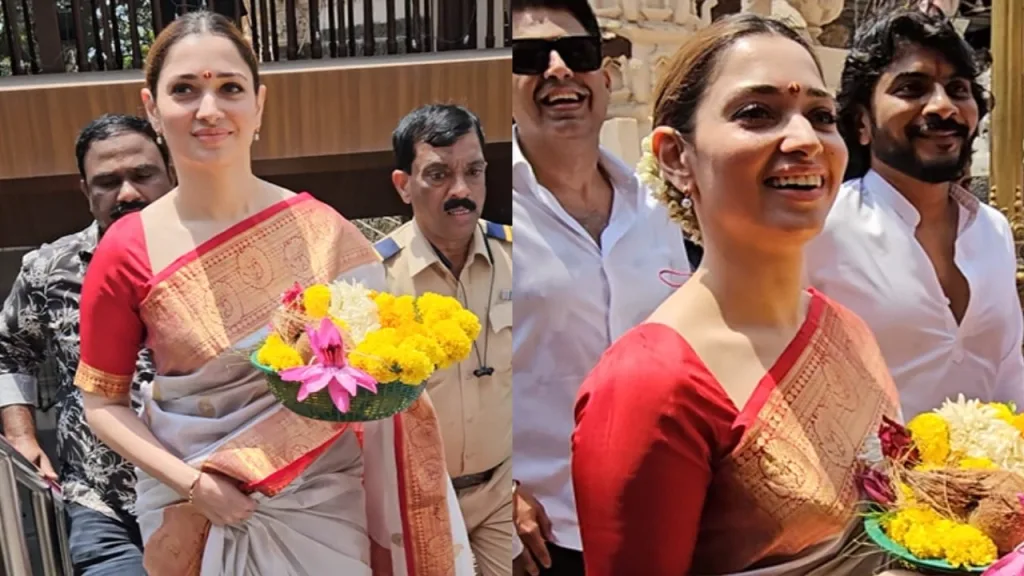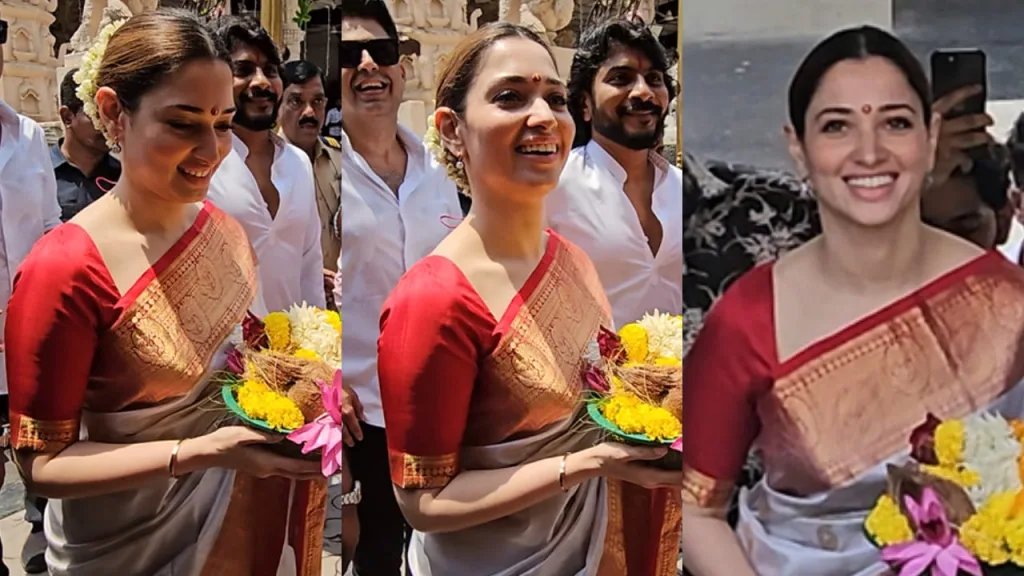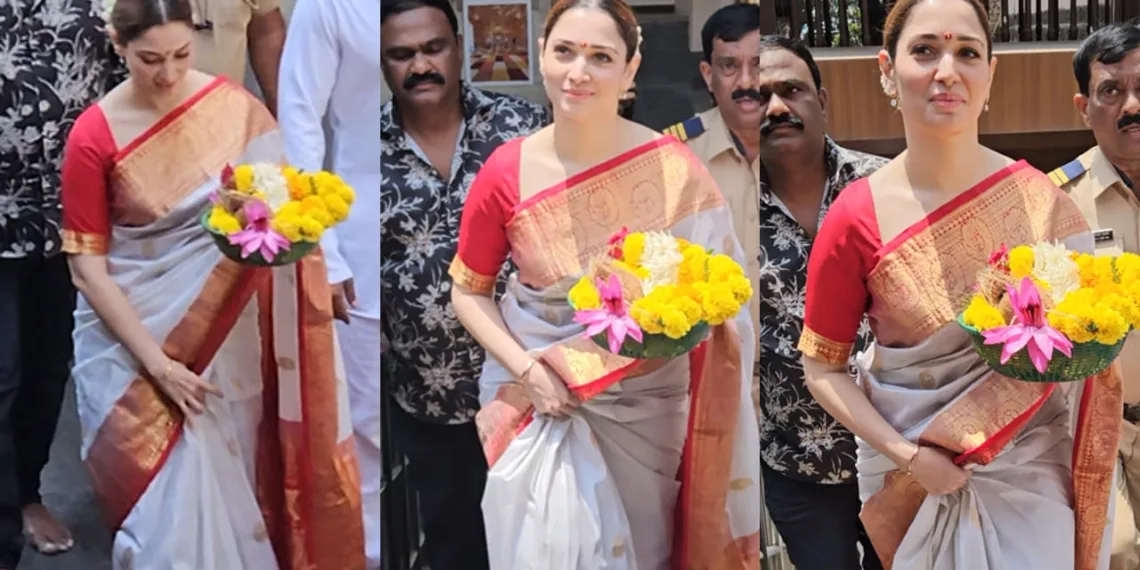The timeless elegance of a traditional South Indian silk saree found its perfect ambassador in Tamannaah Bhatia during her recent temple visit for the Odela 2 trailer launch in Mumbai. In an era where Western fashion often dominates celebrity wardrobes, Bhatia’s choice to embrace cultural authenticity speaks volumes about her deep connection to her cinematic roots in Tollywood. The actress, who has seamlessly crossed over between multiple film industries, demonstrated how traditional attire can make a powerful fashion statement while honoring sacred spaces.
Her carefully curated ensemble not only showcased the exquisite craftsmanship of South Indian silk weaves but also highlighted how traditional accessories like the gajra (floral hairpiece) can transform a look into something truly magnificent. As she gracefully entered the temple premises barefoot, Tamannaah embodied the perfect harmony between celebrity glamour and respectful cultural observance.
Table of Contents
Tamannaah Bhatia South Indian Saree Look: Traditional Elegance Meets Modern Grace
Tamannaah Bhatia brought regal sophistication to her Odela 2 promotional event with a stunning traditional South Indian silk saree that perfectly balanced cultural authenticity with her signature grace. The actress chose a harmonious color palette of red, golden, and light grey—colors that hold significant cultural importance in South Indian traditions. The light grey base of the saree featured delicate golden motifs throughout, while a striking red and gold border provided the perfect framing for the elegant drape.

Demonstrating her intimate understanding of South Indian saree styling, Tamannaah opted for a non-pleated dupatta that flowed gracefully over her arms, creating a sense of movement and fluidity. Her blouse choice maintained cultural authenticity with its half-sleeved red design, complemented by intricate golden border work that echoed the saree’s detailing. This thoughtful coordination created a harmonious look that honored traditional aesthetics while feeling fresh and contemporary.
As she entered the temple premises ahead of the evening’s trailer launch, Tamannaah’s respect for sacred spaces was evident in every detail of her appearance. Walking barefoot in accordance with temple traditions, she carried a small basket containing flowers and a coconut for her prayers. These mindful gestures highlighted the actress’s deep respect for cultural practices, even amid the promotional responsibilities of her upcoming film.
| Element | Description | Cultural Significance |
|---|---|---|
| Saree | Light grey silk with gold motifs and red border | Traditional South Indian temple attire |
| Blouse | Half-sleeved red with gold border | Complements saree while maintaining modesty |
| Hair | Sleek bun adorned with gajra (floral garland) | Symbol of auspiciousness and celebration |
| Accessories | Simple gold bangles, small earrings, red and yellow tikka | Traditional temple adornments |
| Offering | Basket with flowers and coconut | Traditional temple prayer items |
The actress’s approach to accessories reflected the same thoughtful restraint, with a few simple gold-toned bangles and subtle earrings that complemented rather than competed with her ensemble. The traditional red and yellow tikka adorning her forehead added an authentic touch that acknowledged the spiritual context of her visit. These carefully chosen elements created a cohesive look that paid homage to South Indian traditions while remaining true to Tamannaah’s personal style.
Perhaps most striking was her classic hairstyle—a sleek bun encircled with multiple layers of fresh jasmine gajra. This traditional floral adornment not only added visual interest but also incorporated a sensory element, as jasmine’s fragrance is an integral part of South Indian cultural experiences. The hairstyle framed her face beautifully while emphasizing the cultural authenticity of her overall appearance.

Tamannaah’s makeup choices perfectly complemented her traditional ensemble with a natural approach that enhanced her features without overpowering the look. A hydrating base with a touch of blush created a fresh complexion, while defined eyes with eyeliner and mascara added subtle drama. Her peachy lip shade completed the balanced look, allowing her natural beauty to shine through while honoring the spiritual setting.
The actress’s temple visit for Odela 2 promotions exemplifies how traditional style can make a powerful statement when executed with authenticity and respect. By embracing the cultural richness of South Indian attire, Tamannaah demonstrates that sometimes the most impactful fashion moments come from honoring tradition rather than chasing trends.
Bollywood Fashion Face-Off: Stars Choose Contrasting Styles at Maddock Films Gala
Frequently Asked Questions
What makes a South Indian silk saree different from other regional saree styles?
South Indian silk sarees are distinguished by several unique characteristics that set them apart from other regional styles. Their most defining feature is the exceptionally high-quality silk used in their creation, particularly in varieties like Kanchipuram (Kanjeevaram), Mysore, and Pochampally silks, which are known for their durability and glossy finish. The weaving technique employs a distinct process where the body and border are woven separately with heavier silk threads and then interlocked, creating sarees that can literally stand on their own due to their weight and stiffness.
Color-wise, South Indian silks traditionally feature vibrant, contrasting combinations with borders and pallu (end piece) that are significantly wider and more elaborate than those in other regions. The motifs typically include temple designs, peacocks, mangoes, coins, and various geometric patterns that hold cultural and religious significance. When wearing these sarees, the traditional South Indian style involves creating pleats in the center rather than to one side, with the pallu draped over the left shoulder in a specific manner that maintains the display of the elaborate border work throughout the garment.
How should one style a gajra with different hairstyles for traditional Indian occasions?
Styling a gajra effectively depends on both the hairstyle chosen and the occasion’s formality. For a classic look similar to Tamannaah’s, a sleek bun positioned at the nape or lower back of the head provides the perfect foundation for wrapping a full gajra in concentric circles, creating an elegant frame that’s ideal for formal events and temple visits. For a modern interpretation, incorporate a half-gajra with a side-positioned bun, allowing the flowers to create an asymmetrical accent that works beautifully for contemporary celebrations. With braided hairstyles, weave smaller sections of gajra throughout the braid for a romantic, feminine effect perfect for mehendi ceremonies or sangeet nights.
Looser hairstyles like soft waves can be adorned with a crescent-shaped gajra positioned at the crown or back of the head, offering a bohemian-inspired take on the tradition suitable for less formal gatherings. When selecting flowers, jasmine remains the traditional choice for its auspicious significance and delicate fragrance, but contemporary styling has embraced rose petals, marigolds, and even hybrid arrangements for personalized effects. The key to successful gajra styling lies in considering proportion—heavier, more elaborate sarees and jewelry generally pair best with simpler gajra arrangements to maintain visual balance, while simpler outfits can support more dramatic floral displays.








